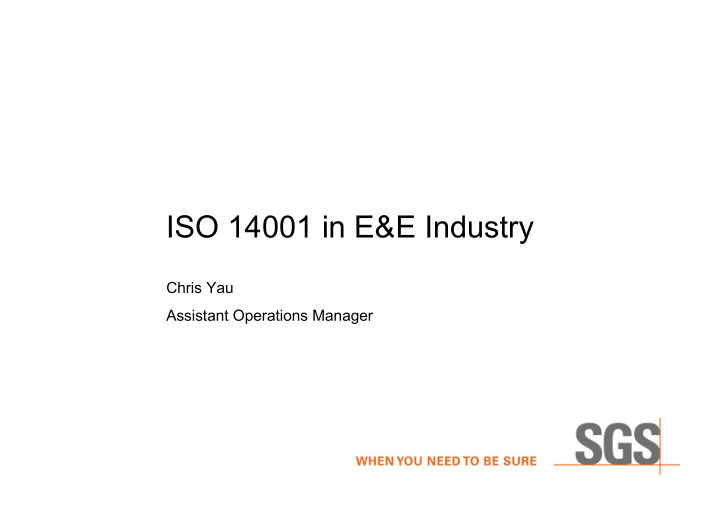



ISO 14001 in E&E Industry Chris Yau Assistant Operations Manager
ISO 14001 certification (by industry) ~74,000 certificates � Electrical and optical equipment � Chemicals and chemical products � Mechanical equipment � Power generation � Construction � Others 2
ISO 14001 certification in Hong Kong and S. China (by industry) � Electrical and optical equipment � Rubber and plastic products � Metals and metallic products � Others • Property management • Cleaning • Transportation • Trading 3
E&E industry � Several industries cover most of the E&E factories in the Pearl River Delta • Fabrication of printed circuit board • Assembly / SMT • Power supplies / transformer / motors / cables / harness • Appliances 4
Common pitfalls in E&E industry’s EMS � Supplier liabilities on fulfilling customer requirements � Unable to demonstrate environmental consideration in purchasing and R&D � No control mechanisms for environmental aspects update � Emergency preparedness covers only natural disasters and accidents � Lack of awareness on chemicals 5
Supplier liabilities on fulfilling customer requirements 6
The Sony lesson � Dutch Inspectorate Blocks Import of Cadmium-Containing Products The Dutch VROM-Inspectorate blocked the import of 2.5 million products worth approximately $248 million USD (€ 226 million) due to significantly high levels of cadmium. The materials were detected by Customs in the Dutch city of Tilburg at the European distribution center of Sony. The quantity of cadmium ranged from 3 to 30 times the allowed concentration. Sony tried to reverse the ban on the products, but the VROM- Inspectorate imposed a penalty with a maximum of $18.5 million (€ 17 million). All products were transported to the United Kingdom, where the parts of the products with illegally high levels of cadmium were replaced and destroyed. � After this incident, Sony reorganized its internal structure in such a way that the responsibility for environmental issues is now at a high level in their organization. They also have started a system of Green Partnership in which all their suppliers are required to participate. Audits will be held and if a supplier does not meet the Green Partner requirements, he or she will be in danger of losing distributor status. � Source: http://www.inece.org/newsletter/8/regional_europe.html 7
Unable to demonstrate environmental consideration in purchasing and R&D � Many organizations view purchasing and R&D (or other similar non-production departments) as simply office operations and hence their environmental aspects are minimal � “…to identify the environmental aspects of its activities, products and services within the defined scope of the environmental management system …” � “…to determine those aspects that have or can have significant impact(s) on the environment…” � Clause 4.3.1 8
Unable to demonstrate environmental consideration in purchasing and R&D � Purchasing • How customer environmental requirements (e.g. WEEE / RoHS requirements) are being incorporated into purchasing decisions? • How is banned substances controlled from being purchased? � R&D • How customer environmental requirements (e.g. WEEE / RoHS requirements) are being incorporated into product design? • How is banned substances controlled from being used in the products? 9
No control mechanisms for environmental aspects update � “The organization shall document this information and keep it up to date.” � Clause 4.3.1 � Many organizations simply have a statement “…environmental aspects register will be updated annually…” in their procedures and relied on the memory of their staff to update the environmental aspects � There needs a more robust control point in their management system to ensure the aspects are updated immediately 10
No control mechanisms for environmental aspects update � Examples of better control point: • A check box in the purchase request form to ensure environmental risk assessment is performed before a new material is purchased • A check box in the Engineering Change Note (ECN) to ensure environmental risk assessment is performed for process change 11
Emergency preparedness covers only natural disasters and accidents � “The organization shall establish, implement and maintain a procedure(s) to identify potential emergency situations and potential accidents that can have an impact(s) on the environment and how it will respond to them.” � Clause 4.4.7. � Natural disasters, although it may cause human death or property damage, does not necessarily create significant environmental impact. 12
Emergency preparedness covers only natural disasters and accidents � Other equipment malfunctions are more likely to cause negative environmental impact, e.g. • Breakdown of wastewater treatment plant • Malfunction of exhaust vent in soldering workshop � Examples of emergency plan: • Do you have a backup measure when the treatment plant breakdown? A buffer tank? • If not, do you continue on production? • Do you have the parts number or suppliers contacts handy? • Do you stock a minimum number of critical parts? 13
Lack of awareness on chemicals � Use of process chemicals • Unclear / unusable MSDS • Staff never briefed on MSDS, as a result: – Storage of incompatible chemicals – Over-stock of chemicals – Improper chemical handling methods – Insufficient spillage / leakage protection – Lack of spillage / leakage kit • Improper disposal / handling of spent chemicals or soiled rigs � Chemicals contained in parts • Heavy metals in paints and pigments • Carcinogens in organic chemicals 14
Recommend
More recommend